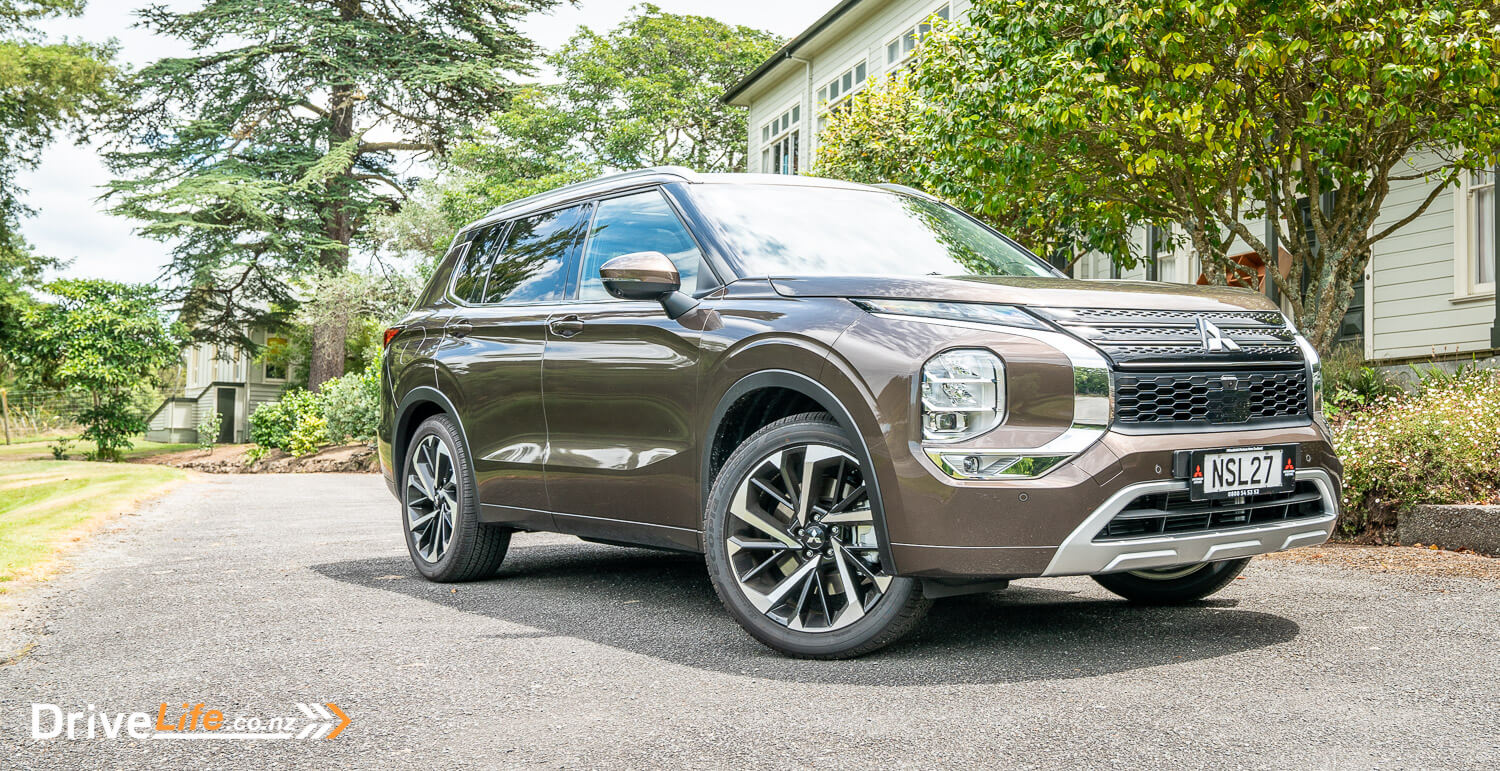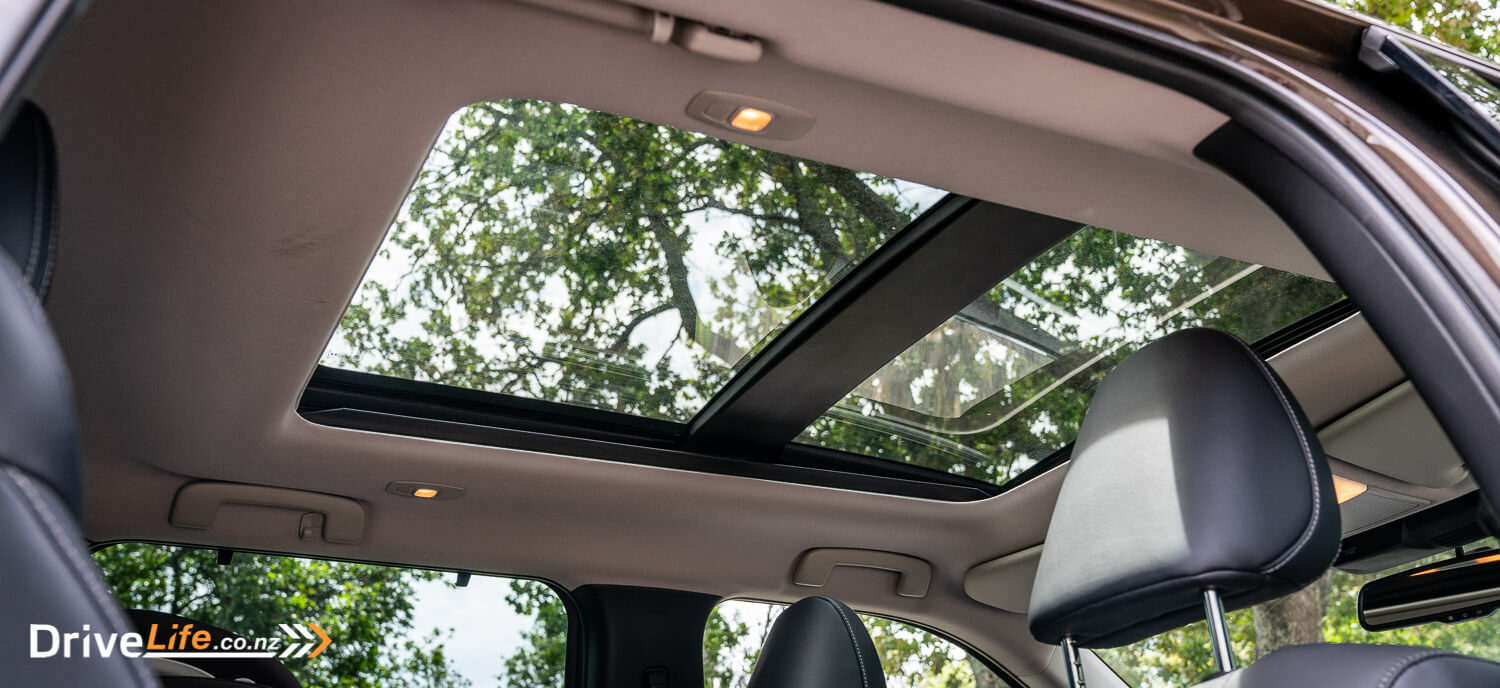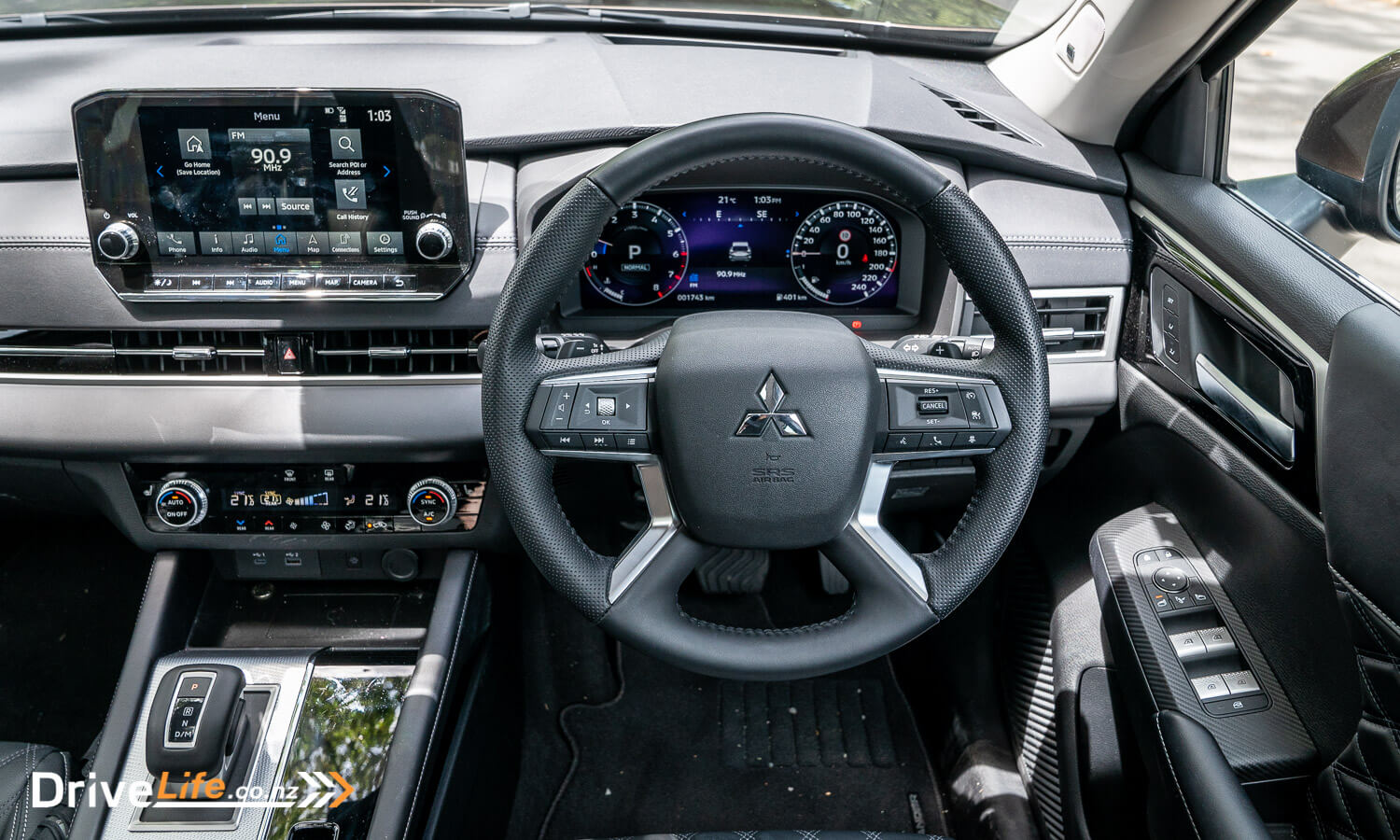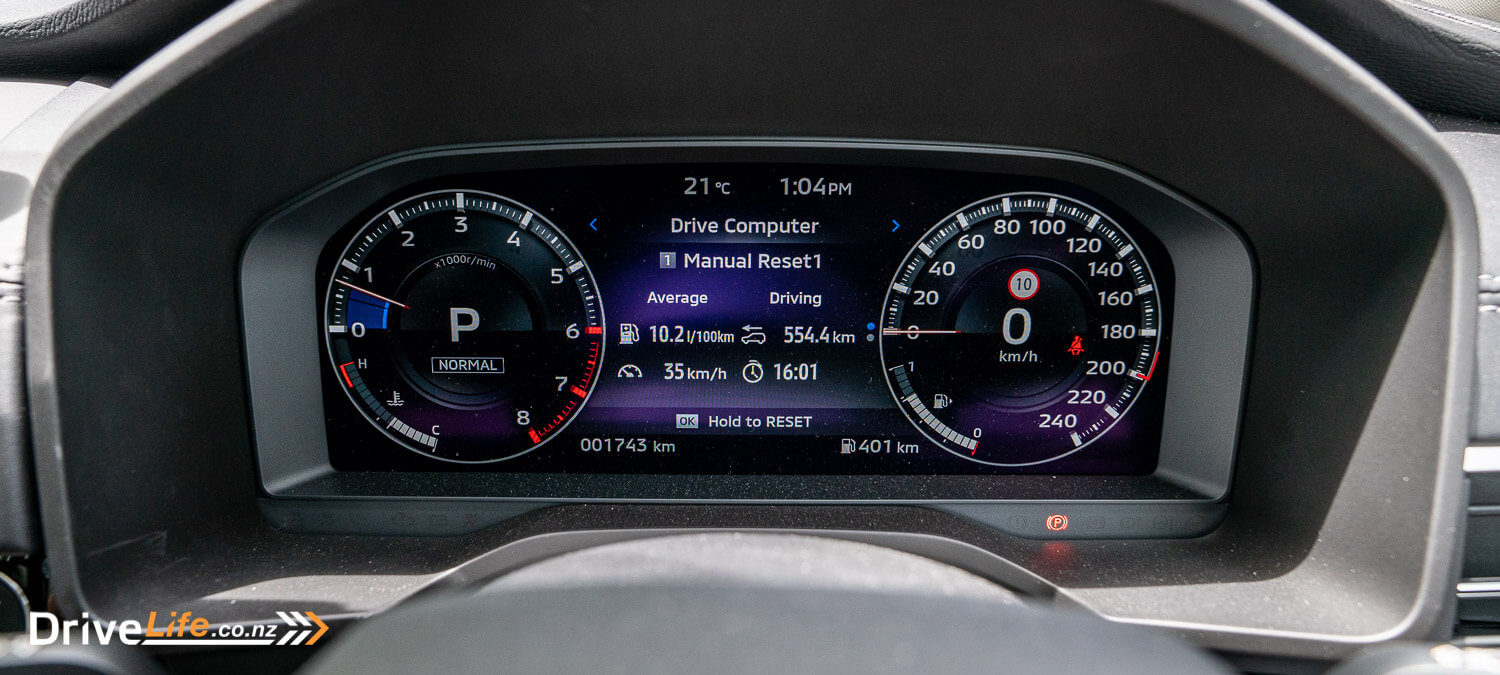The Mitsubishi Outlander has been a stable workhorse for many New Zealand families. The team at DriveLife have reviewed many generations of the Outlander and it has always ranked well with us. The main reason for this was that it was simple, practical and great value for money. The only areas we always felt it was struggling in were the interior and tech level specs.
However, for the price, we still ranked it high as it was of great value. Now the fully redesigned 2021 Outlander is here and I got to spend 4 weeks behind the wheel over the Christmas holidays. This would really put it to the test, everyday family life, a road trip and a family holiday.
Will the new Mitsubishi Outlander knock it out of the park with its major redesign?

What We Like and Dislike About The 2021 Mitsubishi Outlander 2.5P VRX 4WD
| What we like |
- Modern styling
- New upmarket Euro-style interior
- Quiet and efficient engine
- High spec level
- Value for money
- Family practical vehicle
- 7 seats
- Large boot space
- Power tailgate
| What we don’t like |
- Auto-hold handbrake
- 3rd-row leg space for kids only

What’s In The 2021 Mitsubishi Outlander Range?
The new Outlander is available in two formats, combustion engine only and as a plug-in hybrid (PHEV). We hope to review the new Outlander PHEV early in 2022, for now, we will just focus on the combustion engine range.
There are six variants of the new Outlander, three of these are 2-wheel drive and three are 4-wheel drive.
- OUTLANDER 2.5P LS 2WD CVT – $41,990
- OUTLANDER 2.5P XLS 2WD CVT – $44,990
- OUTLANDER 2.5P VRX 2WD CVT – $49,990
- OUTLANDER 2.5P LS 4WD CVT – $44,990
- OUTLANDER 2.5P XLS 4WD CVT – $49,990
- OUTLANDER 2.5P VRX 4WD CVT – $54,990
There are 3 spec levels across the range, LS, XLS and VRX. The main difference between these trim levels is that the LS is the 5 seater, while the XLS and VRX are both 7 seaters, and the VRX has leather seats, a panoramic sunroof and a power tailgate.
All vehicles share the same engine, a 2.5 L DOHC MIVEC petrol engine. This engine creates 135kW of power and 245Nm of torque. It gets the power to the wheels by a CVT automatic gearbox that has a Sports Mode and Paddle Shift gear selection on the steering wheel. The 4 wheel drive variants also come with a Super All-Wheel Control (S-AWC) system, allowing it the ability to do light off-roading.
The VRX has a huge spec level, which you can see below and on the Mitsubishi New Zealand website.

2021 Mitsubishi Outlander 2.5P VRX 4WD Standard Equipment Highlights
- 7 Seats
- 9″ Touchscreen SDA System (Android Auto & Wireless Apple CarPlay Compatible), Navigation System and AM/FM Radio
- 20″ Machine-finished Alloy Wheels with Steel Space Saver
- Sunshade (2nd row)
- Smartphone Wireless Charging
- Push Button Start
- Keyless Operation System
- Triple Zone Climate Control
- Electric Windows – All Auto up/down with anti-trapping function
- Cruise Control
- Power Tailgate with Handsfree Access
- Door Mirrors heated and folding with turn signal, reverse auto tilt and memory function
- Adaptive LED Headlamps with Auto Levelling and Front Sequential Turn Indicators
- Roof Rails
- Panoramic Sun Roof
- LED Daytime Running Lights
- Drive Mode Selector – Tarmac, Gravel, Snow, Normal, Eco and Mud
- Driver’s seat – heated with 8-way power-adjustable, with power lumbar support and memory function
- Front Passenger’s Seat – heated with 8-way power-adjustable, with power lumbar support and memory function
- 4-Wheel ABS with EBD, ASC, Traction Control and AYC
- Electronic with Brake Auto Hold
- Brake Assist
- USB x4 (type A and C, 2 ports charging only) with Wireless Bluetooth Audio Streaming
- BOSE premium sound system with 10 speaker
- Reverse Camera
- Emergency Lane Assist
- Traffic Sign Recognition System
- Driver Attention Alert
- Lane Departure Prevention
- Moving Object Detection
- Forward Collision Mitigation (FCM) (with Pedestrian / Cyclist Detection & Junction Assist)
- Active Blind Spot Assist
- Rear Automatic Emergency Braking (Rear AEB)
- Adaptive LED Headlights (ALH)
- Rear Seat Alert
- Traction Control
- Adaptive Cruise Control (ACC)
- Adjustable Speed Limiter
- Airbags – Driver, Passenger, Center Front, Side, Curtain and Driver’s Knee Airbags
- Blind Spot Warning (BSW)
- Hill Start Assist
- Lane Departure Warning (LDW)
- Parking Sensors
- Front and Rear
- Multi Around View Monitor
- Lane Change Assist (LCA)
- Rear Cross-Traffic Alert
- Head up Display
- Hill Descent Control
Our Review Vehicle’s Optional Equipment
Mitsubishi have always been good about giving you trim levels options instead of optional extras. There is a wide range of vehicle accessories, but the VRX pretty much has all the options at the retail price is $54,990
For a full list of specs and options available for the Mitsubishi Outlander jump on over to the Mitsubishi New Zealand website
How Does The 2021 Mitsubishi Outlander 2.5P VRX 4WD Compare To Its Competition?
The SUV and 7-seat vehicle market is the second largest segment in New Zealand, with fierce competition. Where the Outlander lacked over the years was its interior spec level and options. It was able to hold its own by offering great value.
Now it’s offering both, which will really shake up things when customers are looking for a brand new family vehicle.
| Make/ Model | Engine | Power/ Torque kW/Nm | Seats | Fuel L/100km | Towing Capacity | Boot Space, litres | Price |
| Ford Everest Titanium | 2.0-Litre Bi-Turbo Diesel | 155 / 500 | 7 | 7.0 | 750, 3100 | 1050 / 2010 | $79,990 |
| Skoda Kodiaq RS | 2.0-litre Turbo Petrol | 180 / 370 | 7 | 7.5 | 720, 2000 | 775 / 2065 | $77,990 |
| VW Tiguan Allspace R-Line | 2.0-litre Turbo Petrol | 162 / 350 | 7 | 8.4 | 720, 2065 | 700 / NA | $77,990 |
| Mazda CX-8 Takami | 2.2-litre Twin-Turbo Diesel | 145 / 450 | 7 | 6.0 | 750, 2000 | 775 / NA | $67,290 |
| Mitsubishi Outlander VRX 4WD | 2.5-Litre Petrol | 135 / 245 | 7 | 8.1 | 750, 1600 | 651 / 1473 | $54,990 |
| Honda CR-V Sport 7 | 1.5-litre Turbo Petrol | 140 / 240 | 7 | 7.3 | 750, 1000 | 936, 1486 | $49,000 |

First Impressions Of The 2021 Mitsubishi Outlander 2.5P VRX 4WD
At first glance, I thought the vehicle I was looking at was the Mitsubishi Triton, their ute. But I was wrong; the new styling from the latest Triton has carried over and it has given the new Outlander a strong stance and presence. It also made the new Outlander look like a big vehicle. I must admit there is a lot going on within their design, with the chrome embellishment on the front and the big grille, but it all works and it looks like a serious bit of kit.
Our review car came with the Deep Bronze exterior paint option. It would not have been my pick, as most people, including myself, instantly referred to it as brown. If I had the choice I would have picked Diamond Red or Atlantic Blue.
Regardless of the colour, it was time to get into the new Outlander, as it would be my home for the next month. This time covers the Christmas break, which also includes a family road trip, so we should be able to put the new Outlander through almost every family situation before its return.

What’s The Interior Like In The 2021 Mitsubishi Outlander 2.5P VRX 4WD?
If you are accustomed to the inside of the previous Outlanders, you would describe it as adequate. They have never been a vehicle that you would say had a luxury interior, that is until now. Every single person that got in the Outlander during my time with it, opened the door and said, “WOW, this is nice”. Even I said it when I opened the door for the first time.
The inside of the new Outlander has been fully redesigned, and it’s been worth the wait. If the Mitsubishi badge was not on the steering wheel, you could very easily convince someone that this was a very high-end European vehicle. What blew everyone’s mind was how much it cost. As a test after each person who said “WOW” got in, I then asked them how much do you think it costs? Nobody came even close to the retail price of $54,990. The answers ranged from $65k to $95k, which really shows that the Outlander is going all-in and lifting its game in the family SUV market.

The front seats are very well-appointed, noticeably finished in the diamond stitch leather which matches the inlay on the doors too. The front seats are extremely comfortable and supportive. Both front seats are 8-way adjustable with power lumbar support, memory function and heating. It didn’t take long to get that golden position and lock it into the memory functions. I don’t have a single complaint about the seats, the only option I found a bit frustrating was the seat slide on exit, which would move the seat back to allow more room to get in and out of the vehicle. This was fine, as long as nobody was in the back. Thankfully there is an option to turn it off, which we did.
The rear seats are appointed in the same way and are also rather comfortable. While the third row of seats was laid down the second row could go all the way back, which gives the passenger a huge amount of leg space behind the front seats. Both outer second-row seats are heated, the middle jump seat is not. Heater controls were found on the rear of the centre console, as were the dual-zone climate controls. Headroom is good in the rear too, and it’s much the same in the third row.

When you want to use the third row, the second-row seats must be pulled forward a bit, as there is no leg room when the second-row seats are all the way back. Once this is done third-row seats pull into place via a grab handle in the boot, super easy to pull up and put away. They never caused us any issues. Not as much space as our Land Rover Discovery has, but the seats are much easier to use. Getting in and out of the third row requires either side second-row seat to be folded forward. They slide and tilt forward to allow the user access to the rear. After a few tests, I felt that the rear is more of a space for kids as getting in and out was a bit tight, as was the legroom.
The infotainment was all combined into a nice 9” touchscreen display in the middle of the dash. The system incorporated the navigation system and AM/FM Radio and also allowed Android Auto & Wireless Apple CarPlay Compatible. Wireless Android Auto is not available, which was a bit of a letdown, as I don’t have an Apple phone. The display itself is not the most futuristic display, controls are simple and it’s easy to use, which is what it needs to be. The audio side of the system was connected to 10 BOSE premium speakers, where you could either use with radio or Bluetooth audio streaming.
Below this display, there was a wireless phone charging pad and 2 USB connections. One is USB A and the other is USB C, which are charging ports only.

One of the main features inside the Outlander VRX is the full tilt and sliding panoramic sunroof. This was a great feature to have for the price bracket of the car, with most European cars still leaving this as an optional extra. The sunroof is split into two glass panels, the front one can move as the rear one is fixed. The front can tilt up, allowing some air in, or it can drop down and slide fully under the rear of the second glass panel, opening up a large space in the roof. The other nice thing about the roof was the sunblind. This worked in three positions, fully opened, fully closed and at the bar that runs across the middle of the frame. This makes sense for those with kids, who might sleep in the car on a long trip. This made it easy to close the blind so the sun is not on them in the rear, while still having it open at the front. The sunroof could even be opened with the blind half-closed too.
Rear view out is brilliant, with the only area being the B-pillar which was a bit larger than I would have liked, creating a bit of a blind spot. A nice little feature for the rear passenger was that the VRX has built-in window shades on both rear passenger doors. Rather handy for younger kids, or those super hot summer days.

The boot is also a great space, with the third row stowed away, the boot space is a practical 655 litres. This held a lot more than you would expect. Our trip away required a week’s stuff for my wife and I, plus our 4-year-old daughter. She required so many more things than we do, so most of the boot was taken up with her bags, bike, scooter, toys, and presents as we were away for Christmas day. But the Outlander has no problems with all of that, while still having the ability to put one of the seats in the second row down if more storage was required. If the second row is down, the boot space opens up to 1,473 litres.
With the third row of seats up, boot space got a bit tight, with under 200 litres, exact figures not available from the manufacturer. But there was enough space to put a few shopping bags.

What’s The 2021 Mitsubishi Outlander 2.5P VRX 4WD Like To Drive?
The new Outlander comes with a range of drive modes, with 2WD or 4WD models available. The drive mode selector on the central console allows you to select from a range of environments. Default is Normal, then you have Eco, Tarmac, Gravel, Snow and Mud. There is a very cool visual aid on the dashboard when you make each selection, making it easy to know which one to use. I was only able to use, Normal, Eco and Tarmac as we never went off-road during our trip. Normal and Tarmac felt much the same, and I assumed Tarmac might be configured for more efficient long drives. Eco, was as you would expect in most cars, a slow responding and lethargic transmission and throttle control, in an effort to avoid quick and inefficient acceleration.
Driving the Outlander would be second nature to previous owners, as the gear selector is a control knob on the central console. This goes from Park to Drive and it can also be used to select Neutral and Manual gear mode. I am not sure why it had this, or the steering wheel paddles as it was never required. The CVT does a great job, so we left it to do its job, making it one less thing to be concerned about.

The engine power was initially a concern of mine, as the output of the 2.5 L DOHC MIVEC petrol engine was lower than I had expected for a vehicle of this size. This engine produces 135kW of power and 245Nm of torque. Not high figures in today’s market, but that doesn’t mean it’s going to be underpowered. My suspicions were correct as the Outlander has the right amount of power to go about your day to day duties and challenges. But if you want to see what it’s like off the lights, you will be disappointed as the engine is set up for efficient driving, not drag racing. What this means is that you can’t really drive this vehicle in an extremely inefficient way, unlike other vehicles with too much power for daily driving. Even over the Remutaka Range, we never felt like the car was underpowered, it was just the right amount for the job.
The ride in the new Outlander is smooth, the undulations in the road are handled well. Even the rougher road surfaces are damped in both feel and sound, which in some cars can be quite bad. There is not much sideways roll in the body when tackling twisty roads like the Remutaka Hill road heading out of Wellington to Masterton. The feel in the wheel is ok, nothing to write home about, but you do know get a good sense of where the wheels are on the road.
Visibility is generally pretty good, out the rear is brilliant, with the only area being the B-pillar which was a bit larger than I would have liked. Even though the new Outlander is a big car, it does not feel big to drive. Much like the older models, it feels light and easy to manoeuvre, compared to its physical size.

The driver’s dash in the new Outlander is a fully digital display with two dials on either side and a large multifunction area in the middle. The central section shows compass direction, vehicle fuel information, navigation, audio and drive mode selection. Unlike other cars where a lot of the vehicle’s settings are accessible via the central display, the Outlander had all of these under the driver’s display. But once I found this out, everything was pretty easy to find. This is where I was able to disable the sliding seat on exit setting. In addition to the driver’s dash, there is also a heads-up display, which is another thing I would not have expected at this price bracket. It’s a simplistic display showing speed and navigation, but it’s great to have as you will look at this over the dash when driving, keeping your vision focused on the road ahead.
The steering wheels controls are good, giving you quick access to audio volume, vehicle information on the dash, vehicle setting menus, phone and cruise control. The only issue that I and my wife found was that setting the cruise control was not as intuitive as you would expect. On several occasions, we both found that it became too much hassle and we would work it out when stopped, forgetting to do so the next time we stopped. Apart from that the rest of the buttons were straightforward and easy to use.

Considering this vehicle is a 7-seat luxury SUV and it retails at $54,990, I was surprised at the range of driver’s aids that are all standard on the VRX. Deep breath and here we go, it’s got a reverse camera, emergency lane assists, traffic sign recognition system, driver attention alert, lane departure prevention, moving object detection, forward collision mitigation, active blind spot assist, rear automatic emergency braking, adaptive LED headlights, rear-seat alert, adjustable speed limiter, airbags – driver, passenger, centre front, side, curtain and driver’s knee airbags, blind-spot warning, hill start assist, lane departure warning, parking sensors front and rear, multi around view monitor of parking, lane change assist, rear cross-traffic alert and hill descent control. For the money, you would have to add several thousand dollars of options to some other cars to get this level of technology.
My only real gripe with the new Outlander was with the handbrake. It’s an electric push and pull button setup, with an auto-hold button option under it. Both work as expected, however, the auto-hold is reset to off every time you start the vehicle, which I found to be very frustrating.

Fuel consumption is another one of the Outlanders strong points. The rated combined consumption from Mitsubishi is 8.1 litres per 100km. Over the time we had the Outlander we managed to get it to 10.1 litres per 100km. But I was left feeling like this number was not right, mainly based on how many times I filled it up over the 4 weeks I was driving it. I covered around 1,500km during this time and I only filled up twice, which is over 700km per fill. We know from the previous models they are really efficient, and I was very happy with how far I was able to get on a tank.
If I was to use one word to describe the drive of the new Outlander, that word would be “Quiet”. The redesign must have added a fair bit of soundproofing as it’s hard to hear the engine without the windows down. This is great as it makes the cabin a good place to be and makes chatting to passengers easier.
Driving the Outlander is much the same as the previous Outlanders. It’s rather uneventful, it’s not fast, or slow, it is not a driver’s car, but it’s not a bad car to drive, it does not have a hard ride or a soft ride. Everything is around the middle, which may sound like useless info, but it’s not.
The new Outlander drives how you would expect it to, no complicated systems, easy to use and it does the job well, making it a rather easy car to live with on the day-to-day.

2021 Mitsubishi Outlander 2.5P VRX 4WD Specifications
| Vehicle Type | SUV |
| Starting Price | $64,990 |
| Price as Tested | $64,990 |
| Engine | 2.5 L DOHC MIVEC Petrol Engine |
| Power, Torque kW/Nm | 135 / 245 |
| Transmission | CVT Automatic with Sports Mode and Paddle Shift |
| Spare Wheel | Spacesaver |
| Kerb Weight, Kg | 1,730 |
| Length x Width x Height mm | 4710 x1862 x 1745 |
| Cargo Capacity, Litres (seats up/seats down) | 655 / 1,473 |
| Fuel tank capacity, litres | 55 |
| Fuel Economy, L/100km | Advertised Spec – Combined – 8.1 Real-World Test – Combined – 10.1 Low Usage: 0-6 / Medium Usage 6-12 / High Usage 12+ |
| Towing Capacity Kg, unbraked/braked | 750 / 1,600 |
| Turning circle metres | 11 Small: 6-10m / Medium 10-12m / Large 12m+ |
| Warranty | Diamond Advantage Warranty 10 year or 160,000km Powertrain Warranty 5 year or 130,000km New Vehicle Warranty |
| Safety information | ANCAP Rating – N/A stars – No Info available Rightcar.govt.nz – 4 Stars – NSL27 |








